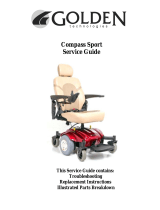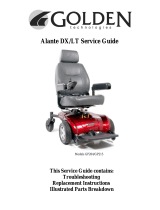
LiteRider PTC_GP162_SG_REVA_051614
2
Table of Contents
Nomenclature and Contact Information .................................................................................................... 3
ABOUT THE LITERIDER PTC SERVICE GUIDE ………………………………............................... 4
LiteRider PTC Components .………………………………………………………………………..... 4-6
The VR2 Controls .................................................................................................................................. 7-8
SCENARIO 1: Press the on/off button and the LED array does not light up ....................................... 9-10
SCENARIO 2: Batteries will not charge ................................................................................................. 10
TROUBLESHOOTING GUIDE for (PG VR2) ................................................................................. 11-16
Step 1: Checking Battery Voltage ............................................................................................................ 11
Control System Status indication ............................................................................................................. 12
Step 2: Checking “Flash Codes” ......................................................................................................... 13-16
Flash Code #1 - Low Battery Voltage ...................................................................................................... 13
Flash Code #2 - Left Motor Disconnected ............................................................................................... 13
Flash Code #3 - Left Motor Wiring Trip .................................................................................................. 14
Flash Code #4 - Right Motor Disconnected ............................................................................................. 14
Flash Code #5 - Right Motor Wiring Trip .......................................................................................... 14-15
Flash Code #6 - Charger Connected ........................................................................................................ 15
Flash Code #7 - Possible Joystick Trip …................................................................................................ 15
Flash Code #8 - Possible Control System Trip ........................................................................................ 15
Flash Code #9 - Solenoid Brake Trip ………...................................................................................... 15-16
Flash Code #10 - High Battery Voltage ................................................................................................... 16
Step 3: Check for other conditions displayed by the PG VR2 Control Unit ........................................... 16
Slow or Sluggish Movement .................................................................................................................... 16
Speed / Profile Indicator is Steady ........................................................................................................... 16
Speed Indication ....................................................................................................................................... 16
Profile Indication ….................................................................................................................................. 16
Speed / Profile Indicator Ripples Up and Down ..................................................................................... 16
Speed / Profile Indicator Flashes ............................................................................................................. 16
How to Read a TruCharge Battery Gauge .…………………………………………………………….. 16
Battery Charging Guidelines ………………………………………………………………………….... 17
Battery Charging .............…………………………………………………………………………… 17-18
Electrical Connections ………………………………………………………………………………...... 19
Wiring Diagram ...............…………………………………………………………………………….... 20
REPLACEMENT INSTRUCTIONS ................................................................................................. 21-24
Drive Wheel ............................................................................................................................................. 21
Rear Caster ............................................................................................................................................... 21
Motor/Brake Assembly ...…………......................................................................................................... 22
Power Module .......................................................................................................................................... 23
Batteries ..………………………………………………………………………………………….... 23-24
APPENDIX A - HOW TO USE A VOLTMETER ……………………………………………………. 25
APPENDIX B - HOW TO USE AN OHM METER ………………………………………………….. 26
ILLUSTRATED PARTS BREAKDOWN ........................................................................................ 27-47






























